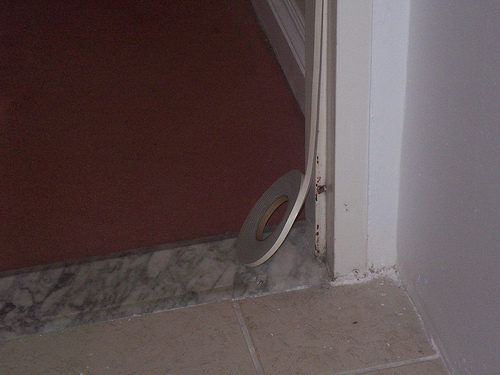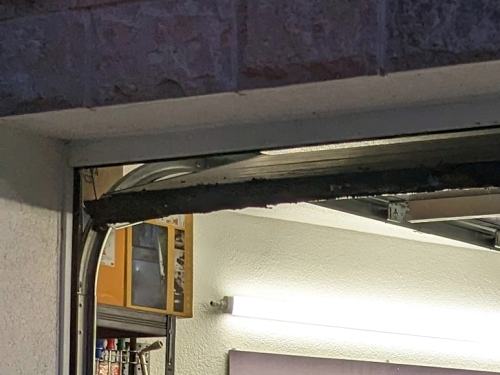The Complete Guide to Weatherstripping Your Garage Doors

The weatherstripping on your garage door helps keep dirt, debris, cold air, pests and intruders from entering the garage and impacting or perhaps endangering the home and everyone in it. Weatherstripping is particularly valuable as a means of keeping winter weather outside where it belongs which in turn keeps your heating bill under control. (If your garage is an icebox it’s going to pull heat from adjoining rooms and make the furnace work overtime to keep up with the loss.) There are a several different types of weatherstripping for your garage door. None of them are particularly expensive or as difficult to deal with as, say, garage door opener repair.
Weatherstripping Advice from the Area’s #1 Garage Door Repair Company
Weatherstripping is one of the unsung heroes of the modern home. Most of the time it goes about its job without anyone paying any particular attention. Once it begins to wear out however, you’ll start to notice things in the garage are colder and draftier and that there’s just something a bit off about the whole garage environment in general
What Constitutes Worn Weatherstripping?

Weatherstripping is one of the unsung heroes of the modern home. Most of the time it goes about its job without anyone paying any particular attention. Once it begins to wear out however, you’ll start to notice things in the garage are colder and draftier and that there’s just something a bit off about the whole garage environment in general.
Like anything else weatherstripping will break down with age. Exposure to the elements, friction and perhaps the efforts of determined pests are other reasons weatherstripping loses its ability to seal your garage door. You should inspect the weatherstripping on your garage door at least once a year, or have it inspected by garage door repair pros. Different types of weatherstripping break down in different ways:
- Rubber and vinyl weatherstripping typically becomes brittle or cracked. If left unattended long enough it will lose its shape and become ineffective at sealing the door.
- Self-adhesive foam tape will suffer from adhesive failure over time and the foam can lose its elasticity which means it won’t spring back and fill the gap.
- V-shaped, spring-metal weatherstripping often winds up coming loose, cracking and becoming bent out of shape. When that happens it loses its viability as a sealant.
Removing Worn Out Weatherstripping
For self-adhesive weatherstripping just grab it by the end and pull it away from the door or frame. With other types of weatherstripping you’ll need to remove the fastening agents before it will come loose so it can be replaced. Keep in mind too that you’ll want to make sure the surface where the old weatherstripping was is clean and clear and ready to accept new material.
Different Ways to Seal the Garage Door with Weatherstripping
There are three ways a Broomfield garage door repair company will apply weatherstripping to your garage door:
The Bottom Seal
The bottom seal is typically a single long strip of vinyl or rubber that is attached to the underside of the door. When the door closes this pliable material compresses against the ground sealing any open areas between the door and the hard surface of the garage floor. Some garage doors have a built in track on the bottom of the door into which the rubber or vinyl strip is slotted. However the bottom strip is attached its importance to maintaining a warm, pest free environment in the garage is crucial.
The Threshold Seal
The threshold seal serves the same purpose as the bottom seal in that it seals any gap between the garage floor and the underside of the door. The difference is that it is attached directly to the floor instead of the bottom of the door. While some who practice garage door repair in Loveland prefer to install the threshold seal if they’re given the option by the customer others see it as potentially interfering with your ability to sweep out the garage. They also point out that it can be worn down by the car passing across it constantly.
Garage Door Frame Weatherstripping
As any company that does garage door repairs knows just as much cold air can infiltrate the garage around the sides and top of the door as may leak in from underneath. In that case you’ll want to consider weatherstripping the entire garage door frame. It’s typically not a difficult or complex operation and can be done by a DIYer on a weekend afternoon. Some weatherstripping kits come with this perimeter weatherstripping and some don’t so be sure to get the kit you need.
A Few Common Sense Installation Tips
Let’s wind this up with a few common sense tips that will make installing weatherstripping around your garage door that much easier.
- Don’t apply your peel-and-stick type weatherstripping if the temperature is less than 50 degree Fahrenheit unless it states on the package that it’s safe to do so.
- Always measure twice before cutting your strips of rubber or vinyl weatherstripping.
- Always face the open end of the V-shaped weatherstripping toward the elements.
If you need to have someone install your weatherstripping for you or fix the garage door on your home call A Better Garage Door today.